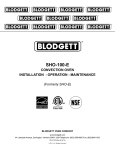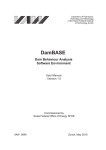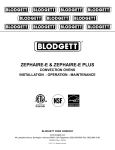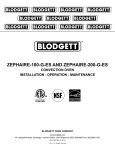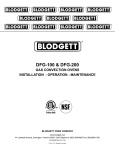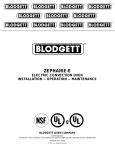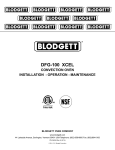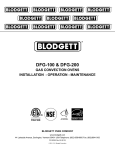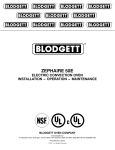Download Blodgett SHO-E-SINGLE Specifications
Transcript
SHO-E ELECTRIC CONVECTION OVEN INSTALLATION -- OPERATION -- MAINTENANCE BLODGETT OVEN COMPANY www.blodgett.com 44 Lakeside Avenue, Burlington, Vermont 05401 USA Telephone (800) 331-5842, (802) 860-3700 Fax: (802)864-0183 PN 37103 Rev A (8/03) E 2003 --- G.S. Blodgett Corporation IMPORTANT WARNING: IMPROPER INSTALLATION, ADJUSTMENT, ALTERATION, SERVICE OR MAINTENANCE CAN CAUSE PROPERTY DAMAGE, INJURY OR DEATH. READ THE INSTALLATION, OPERATING AND MAINTENANCE INSTRUCTIONS THOROUGHLY BEFORE INSTALLING OR SERVICING THIS EQUIPMENT FOR YOUR SAFETY Do not store or use gasoline or other flammable vapors or liquids in the vicinity of this or any other appliance. The information contained in this manual is important for the proper installation, use, and maintenance of this oven. Adherence to these procedures and instructions will result in satisfactory baking results and long, trouble free service. Please read this manual carefully and retain it for future reference. Errors: Descriptive, typographic or pictorial errors are subject to correction. Specifications are subject to change without notice. THE REPUTATION YOU CAN COUNT ON For over a century and a half, The Blodgett Oven Company has been building ovens and nothing but ovens. We’ve set the industry’s quality standard for all kinds of ovens for every foodservice operation regardless of size, application or budget. In fact, no one offers more models, sizes, and oven applications than Blodgett; gas and electric, full-size, half-size, countertop and deck, convection, Cook’n Hold, Combi-Ovens and the industry’s highest quality Pizza Oven line. For more information on the full line of Blodgett ovens contact your Blodgett representative. Model: Your Service Agency’s Address: Serial Number: Your oven was installed by: Your oven’s installation was checked by: Table of Contents Introduction Oven Description and Specifications . . . . . . . . . . . . . . . . . . . . . . . . . . . . . . . . 2 Installation Delivery and Location . . . . . . . . . . . . . . . . . . . . . . . . . . . . . . . . . . . . . . . . . . . . . Utility Connections --- Standards and Codes . . . . . . . . . . . . . . . . . . . . . . . . . Oven Assembly . . . . . . . . . . . . . . . . . . . . . . . . . . . . . . . . . . . . . . . . . . . . . . . . . . NSF Bolts . . . . . . . . . . . . . . . . . . . . . . . . . . . . . . . . . . . . . . . . . . . . . . . . . . . . Leg Attachment . . . . . . . . . . . . . . . . . . . . . . . . . . . . . . . . . . . . . . . . . . . . . . . Caster Assembly . . . . . . . . . . . . . . . . . . . . . . . . . . . . . . . . . . . . . . . . . . . . . . Double Section Assembly . . . . . . . . . . . . . . . . . . . . . . . . . . . . . . . . . . . . . . Oven Leveling . . . . . . . . . . . . . . . . . . . . . . . . . . . . . . . . . . . . . . . . . . . . . . . . 3 4 5 5 6 6 7 7 Operation Standard Control . . . . . . . . . . . . . . . . . . . . . . . . . . . . . . . . . . . . . . . . . . . . . . . . . General Guidelines for Operating Personnel . . . . . . . . . . . . . . . . . . . . . . . . . Suggested Times and Temperatures . . . . . . . . . . . . . . . . . . . . . . . . . . . . . . . . 8 9 10 Maintenance Cleaning and Preventative Maintenance . . . . . . . . . . . . . . . . . . . . . . . . . . . . . Troubleshooting Guide . . . . . . . . . . . . . . . . . . . . . . . . . . . . . . . . . . . . . . . . . . . . 11 12 Introduction Oven Description and Specifications Cooking in a convection oven differs from cooking in a conventional deck or range oven since heated air is constantly recirculated over the product by a fan in an enclosed chamber. The moving air continually strips away the layer of cool air surrounding the product, quickly allowing the heat to penetrate. The result is a high quality product, cooked at a lower temperature in a shorter amount of time. Blodgett convection ovens represent the latest advancement in energy efficiency, reliability, and ease of operation. Heat normally lost, is recirculated within the cooking chamber before being vented from the oven: resulting in substantial reductions in energy consumption and enhanced oven performance. Air Flow Pattern for Blodgett Convection Ovens Figure 1 ELECTRICAL SPECIFICATIONS -- SH1E/AA L1 L2 L3 N Electrical Connection AWG* 1 51 0 51 --- 6 208 3 31 29 29 --- 8 11 240 1 44 0 44 --- 6 11 240 3 26 24 26 --- 8 11 440 3 14 13 14 --- 12 11 480 3 15 14 15 --- 12 KW/Section Volts Phase 11 208 11 Amperes 60 HZ UNITS * Electric connection wiring is sized for 90_C copper wire at 125% of rated input. 2 Installation Delivery and Location DELIVERY AND INSPECTION OVEN LOCATION All Blodgett ovens are shipped in containers to prevent damage. Upon delivery of your new oven: The well planned and proper placement of your oven will result in long term operator convenience and satisfactory performance. D D Inspect the shipping container for external damage. Any evidence of damage should be noted on the delivery receipt which must be signed by the driver. Uncrate the oven and check for internal damage. Carriers will accept claims for concealed damage if notified within fifteen days of delivery and the shipping container is retained for inspection. The following clearances must be maintained between the oven and any combustible or non-combustible construction. D D D D The Blodgett Oven Company cannot assume responsibility for loss or damage suffered in transit. The carrier assumed full responsibility for delivery in good order when the shipment was accepted. We are, however, prepared to assist you if filing a claim is necessary. D Oven body right side --- 0” (0 cm) Oven body left side --- 0” (0 cm) Oven body back --- 0” (0 cm) Oven body bottom --- 4.5” (11.4 cm) Oven body top (for direct vent installations only) --- 8” (20 cm) The following clearances must be available for servicing. D D Oven body sides --- 12” (30 cm) Oven body back --- 12” (30 cm) Keep the oven area free and clear of all combustibles such as paper, cardboard, and flammable liquids and solvents. Do not place the oven on a curb base or seal to a wall. This will restrict the flow of air and prevent proper ventilation resulting in damage to the oven. Before making any utility connections to this oven, check the rating plate to be sure the oven specifications are compatible with the electrical services supplied for the oven. 1. The rating plate is attached under ledge above the door. 3 Installation Utility Connections --- Standards and Codes U.S. and Canadian installations THE INSTALLATION INSTRUCTIONS CONTAINED HEREIN ARE FOR THE USE OF QUALIFIED INSTALLATION AND SERVICE PERSONNEL ONLY. INSTALLATION OR SERVICE BY OTHER THAN QUALIFIED PERSONNEL MAY RESULT IN DAMAGE TO THE OVEN AND/OR INJURY TO THE OPERATOR. Installation must conform with local codes, or in the absence of local codes, with the National Electrical Code, ANSI/NFPA 70 ---Latest Edition and/or Canadian National Electric Code C22.2 as applicable. General export installations Qualified installation personnel are individuals, a firm, a corporation, or a company which either in person or through a representative are engaged in, and responsible for: Installation must conform with Local and National installation standards. Local installation codes and/or requirements may vary. If you have any questions regarding the proper installation and/or operation of your Blodgett oven, please contact your local distributor. If you do not have a local distributor, please call the Blodgett Oven Company at 0011-802-860-3700. the installation of electrical wiring from the electric meter, main control box or service outlet to the electric appliance. Qualified installation personnel must be experienced in such work, familiar with all precautions required, and have complied with all requirements of state or local authorities having jurisdiction. D 4 Installation Oven Assembly NSF BOLTS 1. Locate the 5/16” bolts that were shipped with the oven. 2. Install the bolts as shown in Figure 2. These bolts are required by NSF to block any exposed hole on the back of an oven. This includes: D D any unit, single or stacked, without a back panel. any holes in stacked units not used for mounting stacking brackets. Double Stacked Units Units without back panels Figure 2 5 Installation Oven Assembly CASTER ASSEMBLY LEG ATTACHMENT 1. Lay the oven on its back. 2. Align the threaded stud in each leg with the nut located inside each bottom corner of the oven frame. Turn the legs clockwise and tighten to the nearest full turn. 3. Align the two leg plate holes in each leg with those in the oven bottom. Secure each leg using two 1/2” bolts. NOTE: If using casters see CASTER ASSEMBLY before proceeding. 4. Tip the oven up on the legs. 5. Level the oven by screwing the adjustable leg feet in or out as necessary. NOTE: Install the locking casters on the front of the oven. Install the non-locking casters on the back of the oven. Casters for Single and Double Stacked Ovens: 1. Attach the legs as described. 2. Pry the adjustable feet out of the legs. 3. Insert one caster into each leg as shown. Tighten the lock nuts to secure the casters. Adjustable Leg Foot Caster Assembly Figure 4 Low Profile Casters for Double Stacked Ovens: 1. Align the three holes in each caster assembly plate with those in the oven bottom. Secure each caster using three 1/2” bolts. 6” (15 cm) Legs Shown Figure 3 Figure 5 6 Installation Oven Assembly DOUBLE SECTION ASSEMBLY 1. Secure the short legs to the bottom sections as described. 2. Place the upper section in position on top of the lower oven. 3. Attach the stacking brackets using the remaining 5/16” bolts shipped with the ovens. WARNING!! When stacking ovens be sure to remove the single oven flue boxes prior to attaching three-piece connector. OVEN LEVELING After assembly, the oven should be leveled and moved to the operating location. 1. The oven can be leveled by adjusting the feet or casters located on the bottom of each leg. Flue Connector Figure 6 7 Operation Standard Control CONTROL DESCRIPTION 1 1. BLOWER HI/LO/OFF SWITCH --- Controls the operation of the blower. If the blower switch is in the OFF position the oven will be turned off. 2. COOL DOWN SWITCH --- When the switch is in the AUTO position, the oven can be used to cook. When the switch is in the MAN position, the oven is cooling down for the next bake. 3. OVEN READY LIGHT - When lit indicates burners are operating. When the light goes out the oven has reached operating temperature. 4. THERMOSTAT - Controls the temperature at which the oven will operate. Temperatures can range from 200-500_F (93-260_C). 5. COOK TIMER - Used to time the length of the cooking operation. When the set time expires, a buzzer will sound. 2 3 4 OPERATION 5 1. Set the COOL DOWN switch (2) to the AUTO position. Turn the THERMOSTAT (4) to the desired operating temperature. 2. Set the BLOWER HI/LO/OFF SWITCH (1) to the HI or LO position. When the OVEN READY light (3) goes out, load the product and set the COOK TIMER (5). 3. When the timer sounds, remove the product. If the next product requires a lower operating temperature, then the cool down mode can be used. Turn the COOL DOWN SWITCH (2) to the MAN position. Make sure that the door is open. 4. Turn the oven off by setting the BLOWER HI/ LO/OFF SWITCH (1) to the OFF position. WARNING!! A complete five minute shutdown must be observed before the oven is relighted. Figure 7 8 Operation General Guidelines for Operating Personnel COOK TIMES AND TEMPERATURES OPERATING TIPS Preheating the oven Pans and Racks Always preheat the oven before baking or roasting. We recommend preheating 50_F (10_C) above the cook temperature to offset the drop in temperature when the doors are opened and cold product is loaded into the oven. Set the thermostat to the cook temperature after the product is loaded. Product or pan height determines how many racks are used. The oven holds up to ten 18” x 26” (45.7 x 66.0 cm) bun pans. Load the oven from the bottom, centering the pans on the rack. Never place a pan or aluminum foil on the bottom of the oven. This obstructs the flow of air and results in uneven baking and roasting. NOTE: For frozen product, preheat the oven 100_F (38_C) above the cook temperature. Roasting To reduce shrinkage when roasting, place meat directly on the racks. Place a sheet pan one-half full of water in the bottom rack position. The water evaporates, increasing humidity in the oven chamber. The pan catches grease from the meat, making oven cleaning easier. Cook Temperatures Generally, cook temperatures should be 50_F (10_C) lower than deck or range oven recipes. If the edges of the product are done but the center is raw, or if there is color variation, reduce the thermostat setting another 15-25_F (10-15_C). Continue to reduce the cook temperature on successive loads until the desired results are achieved. Baking Weigh the product to ensure equal distribution in each pan. Varying amounts of product will cause uneven baking results. NOTE: Cooking at excessive temperatures will not reduce cook time, it will produce unsatisfactory baking and roasting results. Fans The fan must be operating for the oven to heat. To avoid rippling of batter product use the following procedure. Cook Time Check the product in about half the time recommended for deck or range oven recipes. Record times and temperatures which provide best results for future reference. 1. Preheat the oven 25_F (15_C) above the baking temperature. 2. Load the oven with product. Close the doors. 3. Set the thermostat to the baking temperature. 4. Turn the oven off. 5. Allow the product to set for 5-7 minutes with the fan off. The residual heat in the oven sets the product. 6. Turn the oven on for the remainder of the bake. NOTE: Cook time will vary with the amount of product loaded, the type of pan and the temperature. 9 Operation Suggested Times and Temperatures Product Temperature Time # Shelves Meats Hamburger Patties (5 per lb) Steamship Round (80 lb. quartered) Standing Rib Choice (20 lbs, trimmed, rare) Banquet Shell Steaks (10 oz. meat) Swiss Steak after Braising Baked Stuffed Pork Chop Boned Veal Roast (15 lbs.) Lamb Chops (small loin) Bacon (on racks in 18” x 26” pans) 400_F (205_C) 275_F (135_C) 235_F (115_C) 450_F (235_C) 275_F (135_C) 375_F (190_C) 300_F (150_C) 400_F (205_C) 400_F (205_C) 8-10 mins. 2 hrs 45 mins. 2 hrs 45 mins. 7-8 mins. 1 hr. 25-30 mins. 3 hrs. 10 mins. 7-8 mins. 5-7 mins. 10 2 2 5 5 5 2 5 10 Poultry Chicken Breast & Thigh Chicken Back & Wing Chicken (21/2 lbs. quartered) Turkey Rolled (18 lb. rolls) 350_F (175_C) 350_F (175_C) 350_F (175_C) 310_F (155_C) 40 mins. 35 mins. 30 mins. 3 hrs 45 mins. 5 5 5 3 Fish and Seafood Halibut Steaks, Cod Fish (frozen 5 oz) Baked Stuffed Lobster (21/2 lb.) Lobster Tails (frozen) 350_F (175_C) 400_F (205_C) 425_F (220_C) 20 mins. 10 mins. 9 mins. 5 3 5 Cheese Macaroni & Cheese Casserole Melted Cheese Sandwiches 350_F (175_C) 400_F (205_C) 30 mins. 8 mins. 5 10 Potatoes Idaho Potatoes (120 ct.) Oven Roasted Potatoes (sliced or diced) 400_F (205_C) 325_F (165_C) 50 mins. 10 mins. 5 5 Baked Goods Frozen Berry Pies (22 oz) Fresh Apple Pie (20 oz.) Pumpkin Pies (32 oz.) Fruit Crisp Bread (24 - 1 lb. loaves) Southern Corn Bread Baking Soda Biscuits Brown & Serve Rolls Sheet Cakes (5 lb. mixed batter per pan) Chocolate Cake Brownies 325_F (150_C) 350_F (175_C) 300_F (150_C) 300_F (150_C) 325_F (155_C) 375_F (190_C) 400_F (205_C) 350_F (175_C) 325_F (160_C) 325_F (160_C) 325_F (150_C) 35 mins. 25-30 mins. 30-50 mins. 25 mins. 30 mins. 15-20 mins. 6 mins. 15 mins. 16-18 mins. 20 mins. 15 mins. 5 (30 pies) 5 (30 pies) 5 (20 pies) 5 3 5 5 5 5 5 5 NOTE: Actual times and temperatures may vary considerably from those shown above. They are affected by weight of load, temperature of the product, recipe, type of pan and calibration of thermostat. Should your recipe vary, write in your proven time and temperature for ready reference. 10 Maintenance Cleaning and Preventative Maintenance CLEANING THE OVEN PREVENTATIVE MAINTENANCE Painted and stainless steel ovens may be kept clean and in good condition with a light oil. 1. Saturate a cloth, and wipe the oven when it is cold. 2. Dry the oven with a clean cloth. The best preventative maintenance measures are, the proper installation of the equipment and a program for routinely cleaning the ovens. On the stainless front or interiors, deposits of baked on splatter may be removed with any nontoxic industrial stainless steel cleaner. Heat tint and heavy discoloration may be removed with any non-toxic commercial oven cleaner. 1. Apply cleaners when the oven is cold. Always rub with the grain of the metal. The porcelain interior can be cleaned with any commercial oven cleaner. Be sure caustic cleaning compounds DO NOT come in contact with the blower wheel and the aluminized steel panel directly behind it. 1. Remove the racks, rack supports and blower wheel cover from the oven. 2. Soak the parts in a solution of ammonia and water. 3. Reinstall after cleaning. Blower Wheel Cover Figure 8 11 Annual Maintenance This oven requires no lubrication, however, the venting system should be checked annually for possible deterioration resulting from moisture and corrosive flue products. If maintenance or repairs are required, contact your local Blodgett service company, a factory representative or the Blodgett Oven company. WARNING!! Always disconnect the appliance from the power supply before servicing or cleaning. Maintenance Troubleshooting Guide POSSIBLE CAUSE(S) SUGGESTED REMEDY SYMPTOM: Elements will not heat S S S S Oven not plugged in. S S S S Power switch on the control panel is off. Control set below ambient temperature. Doors are open. Plug in electrical supply cord. Set the control panel to COOK or OVEN ON. Set to desired cook temperature. Close doors. SYMPTOM: Oven does not come to ready. S The oven has not reached preheat temperature. S Wait for oven to reach preheat temperature. S Internal problem with main temperature control. S * SYMPTOM: Convection fan does not run. S Oven is not plugged in. S Circuit breaker tripped. S Doors are open S Plug in electrical supply cord. S Reset the breaker. S Close doors. SYMPTOM: General baking problems. S Thermostat out of calibration. S Improper oven venting. S * S * *Denotes remedy is a difficult operation and should be performed by qualified personnel only. It is recommended, however, that All repairs and/or adjustments be done by your local Blodgett service agency and not by the owner/operator. Blodgett cannot assume responsibility for damage as a result of servicing done by unqualified personnel. WARNING!! Always disconnect the power supply before cleaning or servicing the oven. 12 CUSTOMER INSERT WIRING DIAGRAM HERE

















